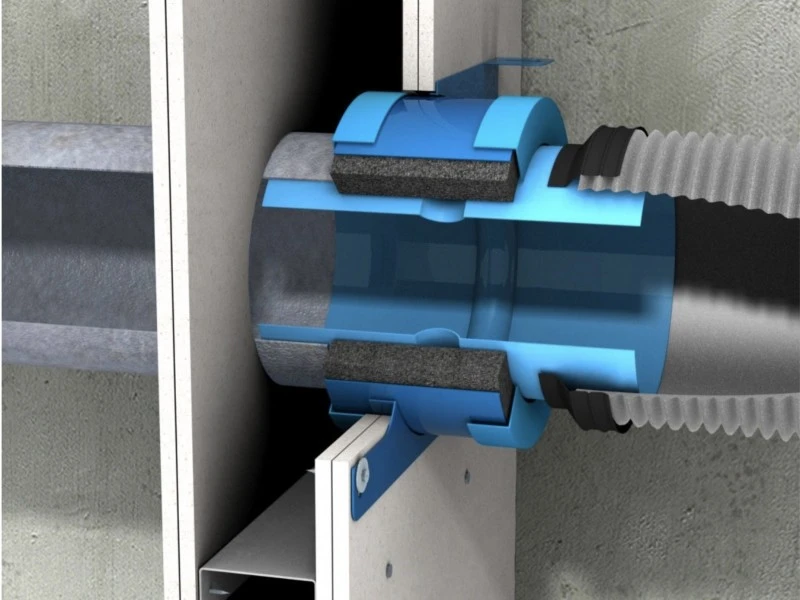When a fire engineer specifies the fire rating of a passive element it is usually in the form of Fire Resistance Rating (FRR) specified by three numbers describing the structural, integrity and insulation rating of the element. Thus a wall with a rating of -/60/60 describes a fire barrier that is not intended for use a structural element and will maintain integrity and insulation for 60 minutes as measured by the failure criteria of a specified standard fire test.
When passive elements of construction such as walls and floors are penetrated by building services such as cables, ducts and pipe-work the fire rating can be significantly reduced. A single penetration in an otherwise entirely compliant wall or floor can allow fire to breach the wall or floor and continue to spread beyond the intended containment fire cell of origin.
Penetrations can be planned as part of the original construction but often times they are an after-thought. No matter when a penetration is required it must be engineered to maintain the original rating of the wall or floor. And when a penetration is no longer required it must be sealed in a manner to ensure that the original rating of the floor or wall is restored.
Don’t be fooled into thinking that ad-hoc grouting, plastering, the use of expanding urethane foams or silicon rubber will maintain the original fire rating. These techniques may close air gaps and look aesthetically pleasing but they mask the problem. Don’t assume that because the plastic pipe is water filled, or because the grouped cables are fully grouted there is no risk of fire transmission through the penetration.
A situation that often arises when services penetrate concrete floors and walls is the need to provide space for the service to be fitted and to provide seismic protection. The resulting gap around the pipe is a potential path for fire propagation through buoyant hot or combustible gases from the floor below, and plastic pipe provides continuity of combustible material through the fire barrier.
There are many techniques for restoring the fire resistance of an element of construction penetrated by services to its original rating. A cost effective and easily applied solution for plastic pipe penetrations are Fire Collars.
So what is a Fire Collar and how do they Work?
In there simplest form a Fire Collar consists of a retaining ring containing an intumescing (expands when subjected to heat) material that is mounted coaxially around the penetrating pipe. Some Fire Collars attach to the exterior of the wall or floor, while others are cast in place. Exterior mounting collars may have a split mounting ring to permit ready installation.
Intumescent materials are the key to the success of Fire Collars and find application in a number of other passive fire protection systems including wraps and seals. There are a number of classes of intumescent including laminar carbon, phyllosilicates and micas. Fire Collars often use carbon intumescents because this material has a high expansion volume and produces a relatively strong compressive force when rapidly heated. Expanding carbon is made from graded flake graphite that has been chemically treated to form intercalation compounds between the layers of carbon in the flakes. When heated above about 150°C the intercalation compounds expand forcing the graphite layers apart
(like an expanding accordion) to form a stable insulating carbon matrix with a volume 100’s of times greater than in the unexpanded state. The graphite is fully expanded at a temperature of about 1,000°C. In production the expanding carbon is mixed with fillers including clays, glass, ceramics, fibres, other intumescents and organic binders to modify the properties of the expanding char and make a stable and flexible product.
When used as a Fire Collar the intumescent expands to form a fire resistant seal around solid objects, and in the case of thermoplastic plastic pipes and conduits, literally squeezing the pipe or duct closed as it softens due to fire exposure.
Horses for Courses
Not all Fire Collars are suitable for every service penetration application. Fire Collars, like the fire rated walls and floors they are used on, are subject to fire resistance testing to confirm that they are suitable for their intended use and will maintain a particular fire rating. A Fire Collar rated for -/60/60 with a 100 mm diameter PVC pipe may not provide adequate fire resistance on a 65 mm diameter pipe. A Fire Collar rated for a particular type of plastic such as PVC, PE or HDPE may not be suitable for use with other plastics. Fire Collars rated for plastic pipe are unlikely to be rated for flexible ducting. Another consideration is smoke separation. Manufacturer’s data should be consulted to select the right Fire Collar for a particular application with consideration of the service, its size, the intended fire rating, ease of installation and aesthetics. Fire collars are available for a number of plastic pipe materials in diameters exceeding 500 mm.
Maintenance
Fire Collars like many passive fire stopping elements need to be inspected from time to time to ensure that they are serviceable. Things to look for include changes in the routed service, that the intumescent is securely in place and has not been degraded by moisture or corrosive environments, that the mounting ring is secure, and that any applied finishes (such as paints, grouting and sealants) that may have been applied are compatible with the collar.
Conclusion
An appropriately selected, installed and maintained Fire Collar can be a simple and effective means to maintaining the fire resistance of passive elements of construction where pipe or service penetrations are required. Another effective weapon in the fire stopping arsenal to control the spread of fire and protect property and life.





